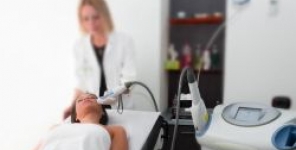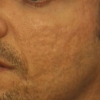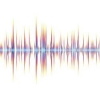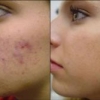L'efficacia del Resurfacing frazionato ablativo utilizzando un 2,940 Nm Er: YAG laser per le cicatrici nel periodo post-traumatico
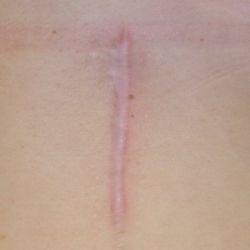 Lesioni cutanee, quali lacerazioni dovute a traumi, sono relativamente comuni, ed i pazienti sono molto preoccupati per le cicatrici che ne derivano. Recentemente, l'uso del laser ablativo e non ablativo basato sull'approccio frazionato è stato usato per trattare le cicatrici. In questo studio, gli autori hanno dimostrato l'efficacia e la sicurezza del resurfacing frazionale ablativo (AFR) per le cicatrici traumatiche utilizzando un laser 2,940-nm erbio: il laser ittrio-alluminio-granato (Er: YAG) per le cicatrici traumatiche dopo la riparazione primaria durante il primo periodo post-traumatico.
Lesioni cutanee, quali lacerazioni dovute a traumi, sono relativamente comuni, ed i pazienti sono molto preoccupati per le cicatrici che ne derivano. Recentemente, l'uso del laser ablativo e non ablativo basato sull'approccio frazionato è stato usato per trattare le cicatrici. In questo studio, gli autori hanno dimostrato l'efficacia e la sicurezza del resurfacing frazionale ablativo (AFR) per le cicatrici traumatiche utilizzando un laser 2,940-nm erbio: il laser ittrio-alluminio-granato (Er: YAG) per le cicatrici traumatiche dopo la riparazione primaria durante il primo periodo post-traumatico.
METODI:
Sono stati inclusi dodici pazienti con quindici cicatrici. Tutti hanno avuto una storia di lacerazione facciale e di riparazione primaria tramite sutura nel giorno del trauma. La laser terapia è stata iniziata almeno 4 settimane dopo la riparazione primaria. Ogni paziente è stato trattato quattro volte a intervalli di 1 mese, con un laser frazionato ablativo 2940-nm Er: laser YAG utilizzando gli stessi parametri. Le valutazioni post-trattamento sono state effettuate 1 mese dopo la quarta sessione di trattamento.
RISULTATI:
Tutti i 12 pazienti hanno completato lo studio. Dopo il trattamento con laser frazionato ablativo, tutte le parti trattate delle cicatrici ha mostrato miglioramenti, come dimostrato dalla Scala della cicatrice di Vancouver e la scala cosmetica globale come valutato da 10 medici indipendenti, 10 non medici indipendenti, e dagli stessi pazienti.
CONCLUSIONI:
Questo studio dimostra che Er frazionato ablativo Er: il trattamento laser YAG delle cicatrici riduce le cicatrici piuttosto in base ad entrambi i risultati oggettivi e ai tassi di soddisfazione del paziente. Gli autori suggeriscono che il trattamento precoce della cicatrice con AFR può essere un adiuvante metodo di gestione della cicatrice per migliorare la qualità della vita dei pazienti con cicatrici traumatiche.
Storia della pubblicazione:
Titolo: The Efficacy and Safety of Ablative Fractional Resurfacing Using a 2,940-Nm Er:YAG Laser for Traumatic Scars in the Early Posttraumatic Period.
Rivista: Arch Plast Surg. 2012 May; 39(3):232-7. Epub 2012 May 10.
Autori: Kim SG, Kim EY, Kim YJ, Lee SI.
Affiliazioni: Seran Plastic Surgery Clinic, Incheon, Korea.
Abstract:
BACKGROUND:
Skin injuries, such as lacerations due to trauma, are relatively common, and patients are very concerned about the resulting scars. Recently, the use of ablative and non-ablative lasers based on the fractional approach has been used to treat scars. In this study, the authors demonstrated the efficacy and safety of ablative fractional resurfacing (AFR) for traumatic scars using a 2,940-nm erbium: yttrium-aluminum-garnet (Er:YAG) laser for traumatic scars after primary repair during the early posttraumatic period.
METHODS:
Twelve patients with fifteen scars were enrolled. All had a history of facial laceration and primary repair by suturing on the day of trauma. Laser therapy was initiated at least 4 weeks after the primary repair. Each patient was treated four times at 1-month intervals with a fractional ablative 2,940-nm Er:YAG laser using the same parameters. Post-treatment evaluations were performed 1 month after the fourth treatment session.
RESULTS:
All 12 patients completed the study. After ablative fractional laser treatment, all treated portions of the scars showed improvements, as demonstrated by the Vancouver Scar Scale and the overall cosmetic scale as evaluated by 10 independent physicians, 10 independent non-physicians, and the patients themselves.
CONCLUSIONS:
This study shows that ablative fractional Er:YAG laser treatment of scars reduces scars fairly according to both objective results and patient satisfaction rates. The authors suggest that early scar treatment using AFR can be one adjuvant scar management method for improving the quality of life of patients with traumatic scars.
https://www.youtube.com/@djfdm
